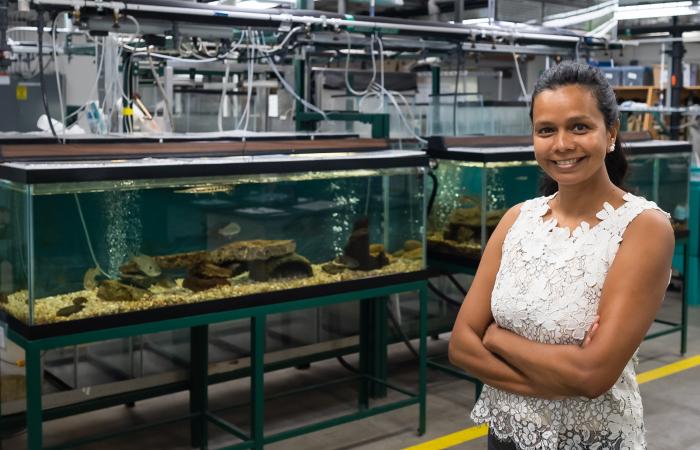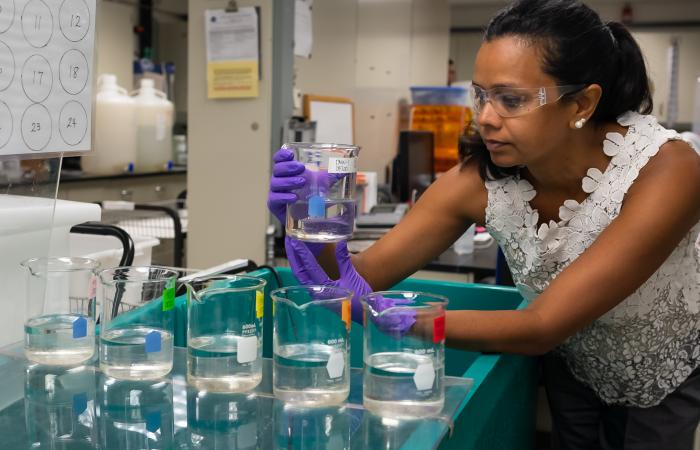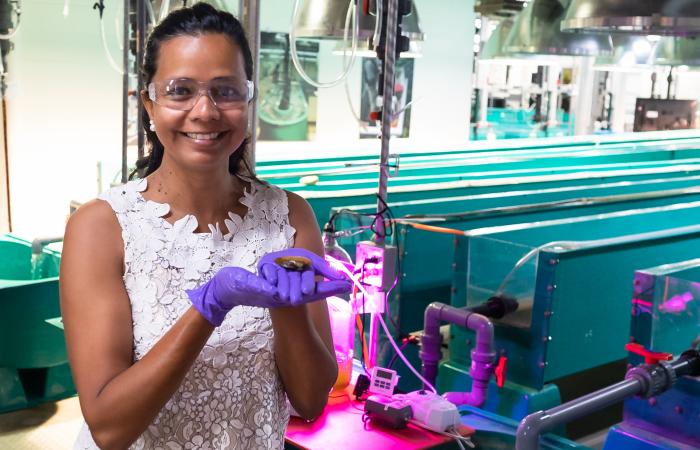-

As the leader of ORNL's Biodiversity and Ecosystem Health Group, environmental scientist Teresa Mathews works to understand the impacts of energy generation on water and solve challenging problems, including mercury pollution. Credit: Carlos Jones/ORNL, U.S. Dept. of Energy
-

As the leader of ORNL's Biodiversity and Ecosystem Health Group, environmental scientist Teresa Mathews works to understand the impacts of energy generation on water and solve challenging problems, including mercury pollution. Credit: Carlos Jones/ORNL, U.S. Dept. of Energy
-

As the leader of ORNL's Biodiversity and Ecosystem Health Group, environmental scientist Teresa Mathews works to understand the impacts of energy generation on water and solve challenging problems, including mercury pollution. Credit: Carlos Jones/ORNL, U.S. Dept. of Energy
-

As the leader of ORNL's Biodiversity and Ecosystem Health Group, environmental scientist Teresa Mathews works to understand the impacts of energy generation on water and solve challenging problems, including mercury pollution. Credit: Carlos Jones/ORNL, U.S. Dept. of Energy
-

As the leader of ORNL's Biodiversity and Ecosystem Health Group, environmental scientist Teresa Mathews works to understand the impacts of energy generation on water and solve challenging problems, including mercury pollution. Credit: Carlos Jones/ORNL, U.S. Dept. of Energy
-

As the leader of ORNL's Biodiversity and Ecosystem Health Group, environmental scientist Teresa Mathews works to understand the impacts of energy generation on water and solve challenging problems, including mercury pollution. Credit: Carlos Jones/ORNL, U.S. Dept. of Energy
Moving to landlocked Tennessee isn't an obvious choice for most scientists with new doctorate degrees in coastal oceanography.
But for environmental scientist Teresa Mathews, making that move launched a rewarding career at the Department of Energy's Oak Ridge National Laboratory, where she leads the Biodiversity and Ecosystem Health Group. As group leader, Mathews oversees diverse projects with a common theme: Understanding how different energy strategies impact the natural world - especially water.
Sources of energy generation from fossil fuels to hydropower can affect water resources in numerous ways, from influencing water flow and temperature to affecting water quality. Mathews' group works to better understand and minimize these environmental impacts.
Mathews' research specifically focuses on how nutrients and contaminants move through aquatic ecosystems. She studies how organisms from microbes to fish influence both the forms in which these chemicals exist in the environment and the ways they move between parts of the ecosystem. She also examines how these chemicals can, in turn, impact biodiversity.
At ORNL, much of her research has centered on mercury, a challenging metal contaminant. Mercury pollution is a growing problem across the world, but it's especially relevant in Oak Ridge, where the metal was released into local waterways during the 1950s and '60s.
Scientists are still addressing legacy mercury contamination, a task complicated by microbes. Through a process called methylation, bacteria transform inorganic mercury into methylmercury. The latter is far more toxic, and it builds up in biological tissues, working its way up the food chain.
"We can do things to control inorganic mercury concentrations, but the microbial transformation of mercury into methylmercury is much more challenging to understand and control," Mathews said. "These questions drive a lot of my research: What are the factors that affect mercury methylation? Are there best management practices or other technologies that we can use to control the factors driving mercury methylation?"
Making an impact
As an undergraduate at New York University, Mathews might have guessed she'd eventually improve public health by combatting a widespread toxin. She double majored in biology and French with plans to attend medical school.
Those plans changed when she interned with a French water company facing a tricky problem: Near the Alps, a lake used for drinking water would experience harmful algal blooms annually.
"A lot of the conventional ways to remove the toxic algae would break the algal cells, releasing the toxins," Mathews said. The challenge blended problem solving, basic sciences, engineering and public health, a combination she found enthralling.
"I realized then that besides medicine, there were lots of other things you could do with science that help people," Mathews said. "You could have a big impact doing environmental science, because improving the environment affects entire communities."
Coastal oceanography to coal ash
For her doctorate degree, Mathews found an advisor she wanted to work with in the Marine Sciences Department at Stony Brook University in New York. She focused her doctoral research on how algae bind to metals in the ocean.
Mathews joined ORNL in 2009 following a postdoctoral appointment with France's Institute for Radiological Protection and Nuclear Safety. There she studied the movement of uranium and other radioactive elements in the environment. More than 70% of France's electricity comes from nuclear power, and Mathews was tasked with evaluating the risks of uranium mining for aquatic ecosystems.
It was in France that she discovered ORNL had an active aquatic ecology lab. "While I was familiar with ORNL's strengths in nuclear science, I hadn't realized that there could be opportunities for someone with my background in oceanography," she said. "When I visited, I fell in love with the place."
At the time, Mathews thought she'd stay two years. Twelve years later, she can't imagine being anywhere else. "I like solving problems that will actually help society, and I think Oak Ridge is one of the best places in the world to do that," she said.
At ORNL, Mathews immediately began leading the type of impact-oriented research that first drew her to environmental science.
She joined a team collaborating with the Tennessee Valley Authority to monitor the site of the Kingston coal ash spill. In 2008, a dike holding ash from a coal plant just miles from ORNL failed and released more than one billion gallons of fly ash into two local rivers. Coal ash contains potentially harmful metals including mercury, selenium, zinc and arsenic. "Our work involved understanding how these metals move through aquatic food webs, which was right up my alley," Mathews said.
Mathews and her team continue to monitor the biological communities in the Kingston vicinity. Because some of the coal ash contaminants build up in aquatic food webs, it may take several years to see long term effects. Selenium is of particular concern, because it can have reproductive impacts in animals like fish and birds. "Thirteen years down the road, we are not seeing long term impacts of selenium bioaccumulation in our aquatic ecosystems," she said.
Meeting the contamination challenge
Upon arrival at ORNL, Mathews also assumed a leadership position in a long-term biological monitoring program tracking mercury concentrations in East Fork Poplar Creek, a contaminated stream that winds through the Oak Ridge Reservation. Not only is she tracking mercury concentrations in the environment, but she and her team are also studying how the biodiversity in the stream responds to clean up actions over the years.
Mathews' group has made significant progress towards understanding the processes that control mercury methylation in the environment and developing solutions to minimize its risks. Collaborating across the lab's Environmental Sciences Division, they've learned that periphyton - algal and microbial communities that coat rocks and other submerged surfaces on streambeds - can be hot spots for methylmercury production.
Her team is using drones to measure how periphyton coverage changes across habitats and seasons. By combining that information with data on sunlight, water quality and nutrient flows, they aim to develop methods to predict when periphyton will be abundant and mercury methylation will be at its highest.
The group is also developing varied approaches to curb methylation. For example, they're testing whether filter-feeding native freshwater mussels could suck mercury out of the water while simultaneously increasing biodiversity and stream health. They've deployed long term tests on using sorbents to bind to mercury for easier removal, with promising results.
Much of this work happens inside ORNL's 8,000 square-foot Aquatic Ecology Lab, where recent upgrades allow scientists to pump water from nearby contaminated waterways into indoor tanks. These simulated streams offer a rare chance to conduct ecological research in a controlled setting.
The world-class facility is one of many research tools Mathews appreciates at ORNL. "For scientists, it's like being a kid in a candy shop," she said.
Never a dull moment
Between her ever-evolving projects, her mix of field and lab work and her management responsibilities, there's no such thing as a typical day for Mathews. Whether she's donning waders to collect water samples or writing a report, she embraces the diversity.
"I like that my job is different every day, that we're pushing the boundaries of our understanding," Mathews said. "We are always moving forward."
The work gets her outside, something she's always loved. Mathews is an avid traveler with hobbies that get her out and about. "East Tennessee is a great place for hiking, kayaking, mountain biking and motorcycling … all things that I love to do," she said. With a 6-month-old at home, these days you're more likely to catch her doing wheelies with a stroller than on a motorcycle, but she intends to share her love of the outdoors with her daughter.
When it comes to her career in science, "I can't imagine doing anything else," Mathews said. "Because you basically get to be a curious kid for the rest of your life. As scientists, we never stop asking questions."






